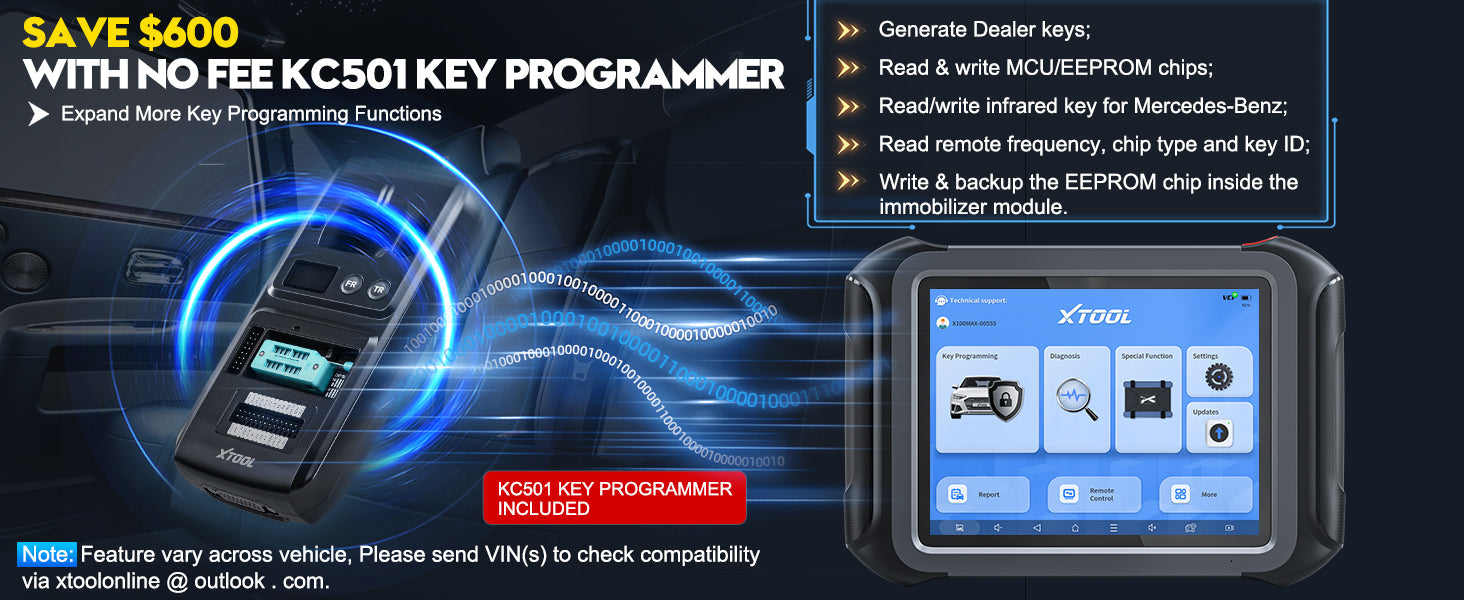Mestring af bilsikkerhed: Forståelse af transpondernøgleprogrammering og hvordan det beskytter dit køretøj
I den moderne bilverden har forebyggelse af biltyveri nået et helt nyt niveau takket være transpondernøgleteknologiDette avancerede system sikrer, at kun autoriserede nøgler kan starte dit køretøj, hvilket gør det næsten umuligt for tyve at koble en nøgle til en anden eller kopiere den uden adgang til bilens startspærresystem. Men hvordan fungerer transponderprogrammering rent faktisk, og hvad involverer opsætningen?
Lad os se nærmere på, hvordan transpondernøgleprogrammering forbedrer køretøjssikkerheden, de involverede trin og de professionelle værktøjer, der bruges af teknikere i dag.
1. Udviklingen af bilnøgler: Fra mekanisk til smart sikkerhed
Traditionelle metalbilnøgler er ved at blive en saga blot. Moderne køretøjer leveres nu med transpondernøgler, som indeholder en lille elektronisk chip inde i nøglens plastikhoved. Når denne chip sættes i tændingen, kommunikerer den med bilens ECU (motorstyringsenhed) eller startspærresystem, verificerer autorisation før motoren starter.
Selv hvis nogen laver en mekanisk kopi af nøglen, vil bilen ikke starte, medmindre ECU'en genkender transponderchippen. Denne teknologi er blevet en af de mest effektive måder at afskrække biltyveri på.
Vigtig indsigt:
Transponderchippen tilføjer et digitalt beskyttelseslag, der sikrer, at kun en korrekt programmeret nøgle kan starte din bil.
2. Hvad er transpondernøgleprogrammering, og hvorfor det er vigtigt
Programmering af transpondernøgler er processen med at synkronisere en ny nøgles elektroniske kode med køretøjets startspærresystem. Uden korrekt programmering vil en erstatningsnøgle – selvom den fysisk passer – ikke blive genkendt af bilen.
Denne proces bliver nødvendig i situationer som:
-
Mistede eller stjålne nøgler: Den gamle nøgle skal slettes, og en ny skal programmeres til køretøjet.
-
Tilføjelse af en reservenøgle: Det er altid klogt at have en backup-programmering til nødsituationer.
-
Nøglefejl: Hvis en transponderchip bliver beskadiget, sikrer omprogrammering eller udskiftning af den fortsat adgang.
Vigtig indsigt:
Programmering skaber et sikkert "håndtryk" mellem din nøgle og ECU. Uden det vil nøglen ikke starte motoren.
3. To hovedmetoder til transponderprogrammering
Afhængigt af din bilmodel og producent kan programmering af transpondernøgler udføres ved hjælp af en af to hovedmetoder:
A. Indbygget programmering (manuel/gør-det-selv)
Nogle ældre bilmodeller giver ejerne mulighed for selv at programmere nye nøgler ved hjælp af en række nøgleomdrejninger og tændingscyklusser. Denne metode er dog sjælden i moderne biler.
B. Programmering af diagnostisk værktøj (professionel/OBD-II-metode)
Til de fleste køretøjer i dag bruger professionelle nøgleprogrammører avancerede diagnostiske værktøjer at kommunikere direkte med køretøjets startspærresystem via OBD-II-portDisse værktøjer kan læse, slette og programmere transponderdata sikkert og præcist.
Vigtig indsigt:
Gør-det-selv-programmering fungerer måske for ældre modeller, men de fleste moderne biler kræver professionelle værktøjer for at sikre præcision og sikkerhed.
4. Sådan fungerer transpondernøgleprogrammering: Trin-for-trin oversigt
Uanset om den udføres manuelt eller med en diagnostisk enhed, følger den generelle proces disse trin:
-
Forbered køretøjet:
-
Sørg for, at bilens batteri er fuldt opladet.
-
Sørg for, at den nye transpondernøgle er kompatibel med dit køretøj.
-
-
Tilslut diagnosticeringsværktøjet:
-
Sæt enheden i OBD-II-porten.
-
Naviger til afsnittet "Nøgleprogrammering" eller "Startspærre".
-
-
Programmér nøglen:
-
Følg instruktionerne på skærmen for at tilføje eller erstatte nøglen.
-
Vent på, at systemet bekræfter, at synkroniseringen er gennemført.
-
-
Test nøglen:
-
Start bilen med den nyprogrammerede nøgle.
-
Kontroller, at startspærrelampen opfører sig normalt.
-
Vigtig indsigt:
Det er afgørende at følge de korrekte trin – en forkert procedure kan forårsage fejl i nøglegenkendelsen eller ECU-spærring.
5. Almindelige problemer og fejlfindingstips
Selv med de rigtige værktøjer kan der opstå et par problemer under nøgleprogrammering:
-
Nøglen vil ikke programmere: Den er muligvis ikke kompatibel, eller chippen er muligvis defekt.
-
Nøglen fungerer ujævnt: Transponderchippen kan være svag eller delvist beskadiget.
-
Bilen vil ikke starte, selv efter programmering: Der kan være en kommunikationsfejl mellem nøglen, ECU'en eller startspærremodulet.
I sådanne tilfælde er professionelt diagnostisk udstyr afgørende for at fastslå årsagen.
6. Anbefalede værktøjer til professionel transpondernøgleprogrammering
For dem, der arbejder som låsesmed eller diagnosticerer biler, sikrer investering i pålideligt programmeringsudstyr nøjagtighed og kompatibilitet med en bred vifte af køretøjer.
To af de mest kraftfulde XTOOL-løsninger er:
-
XTOOL X100MAX med KC501 – En professionel tablet-scanner, der understøtter nøgleprogrammering, IMMO-funktioner, ECU-kodning og chiplæsning. KC501-adapteren udvider mulighederne for transponder- og EEPROM-operationer.

-
XTOOL X100PAD3 med KC100 – Designet til avanceret nøgleprogrammering og startspærrefunktioner. KC100-adapteren muliggør hurtig transpondergenkendelse, nøglegenerering og fjernprogrammering.

Begge værktøjer understøtter omfattende køretøjsdækning på tværs af U.S., europæiske og asiatiske mærker, hvilket gør dem ideelle til både autoværksteder og låsesmede.
7. Ud over nøgler: Fremtiden for bilsikkerhed
Transponderteknologi er ikke længere begrænset til tændingssystemer. Den omfatter nu også smarte nøglebrikker, push-start-systemer, og nøglefri adgangsmodulerEfterhånden som køretøjer bliver mere forbundet, bliver evnen til sikkert at programmere og administrere disse systemer en vigtig færdighed for moderne teknikere.
Vigtig indsigt:
Transponderprogrammering udvikler sig i takt med køretøjsteknologien – ved at holde dig opdateret sikrer du, at din bil eller virksomhed forbliver sikker og effektiv.
Konklusion
Programmering af transpondernøgler er mere end blot en teknisk proces – det er fundamentet for moderne køretøjssikkerhed. Uanset om du er en professionel tekniker eller en bilejer, der ønsker at forstå dit køretøj bedre, hjælper det med at beskytte din investering at vide, hvordan transpondersystemer fungerer.
Og med pålidelige værktøjer som f.eks. XTOOL X100MAX med KC501 og XTOOL X100PAD3 med KC100, bliver nøgleprogrammering hurtigere, sikrere og mere effektiv – hvilket giver både sikkerhed og ro i sindet.

